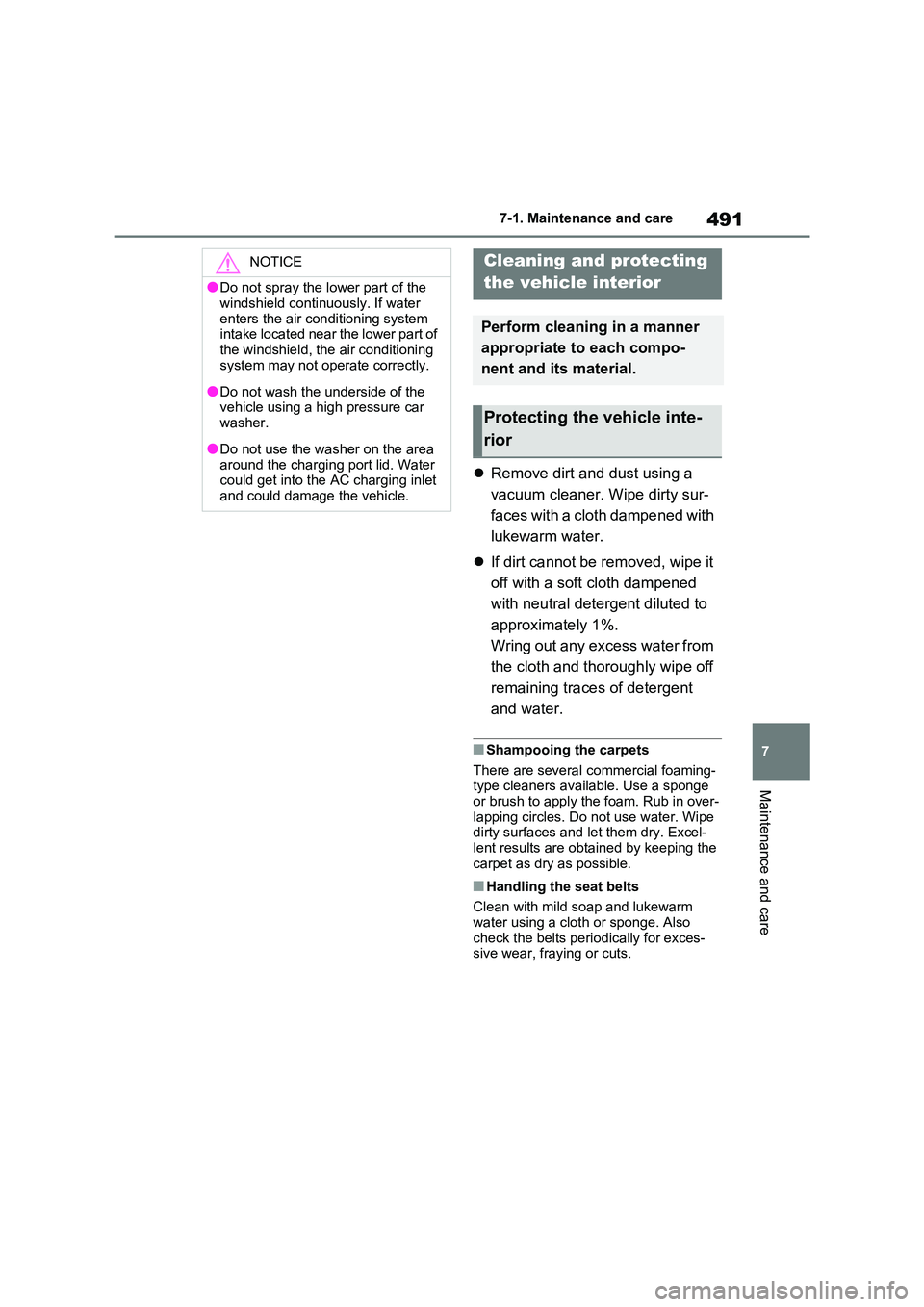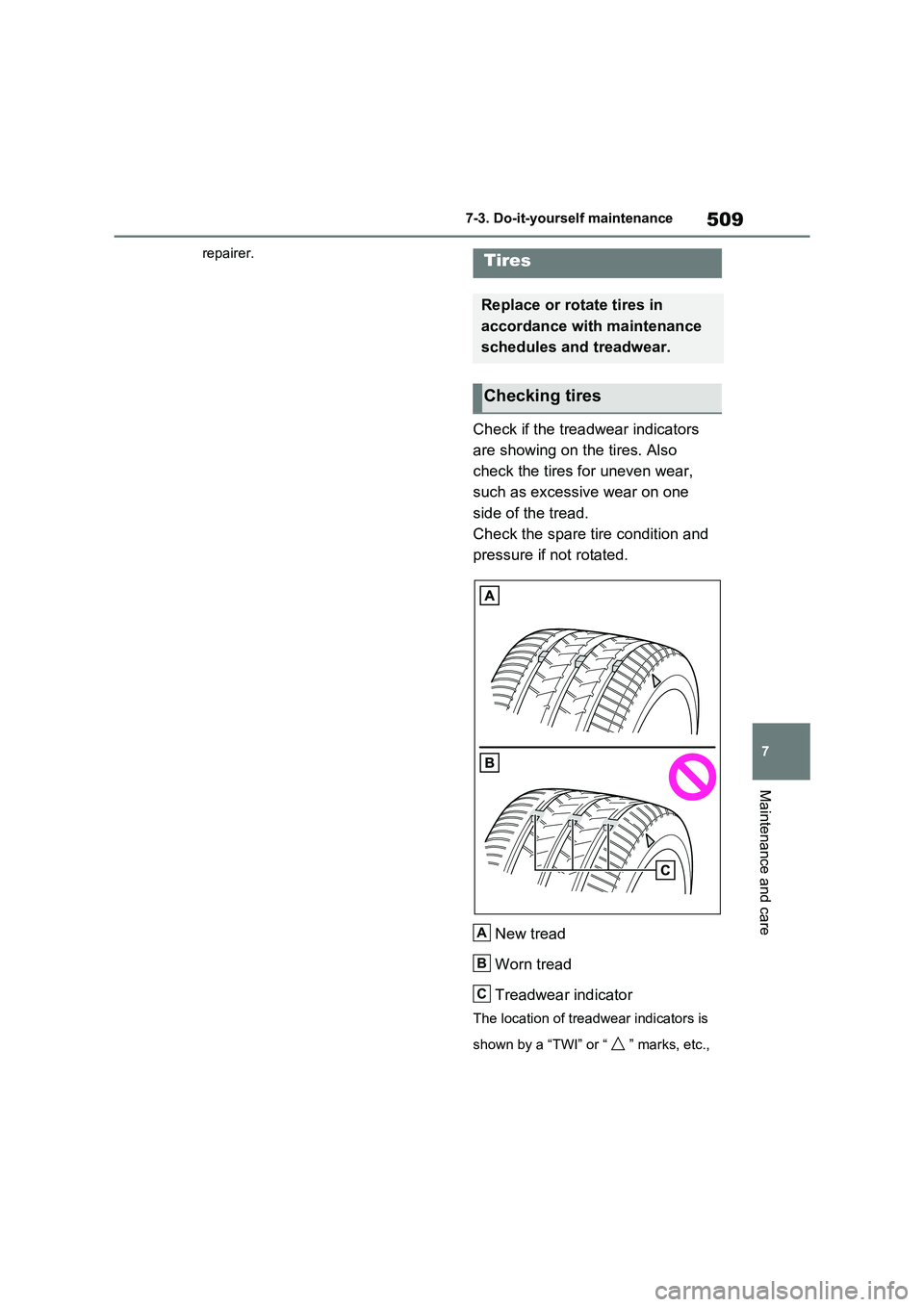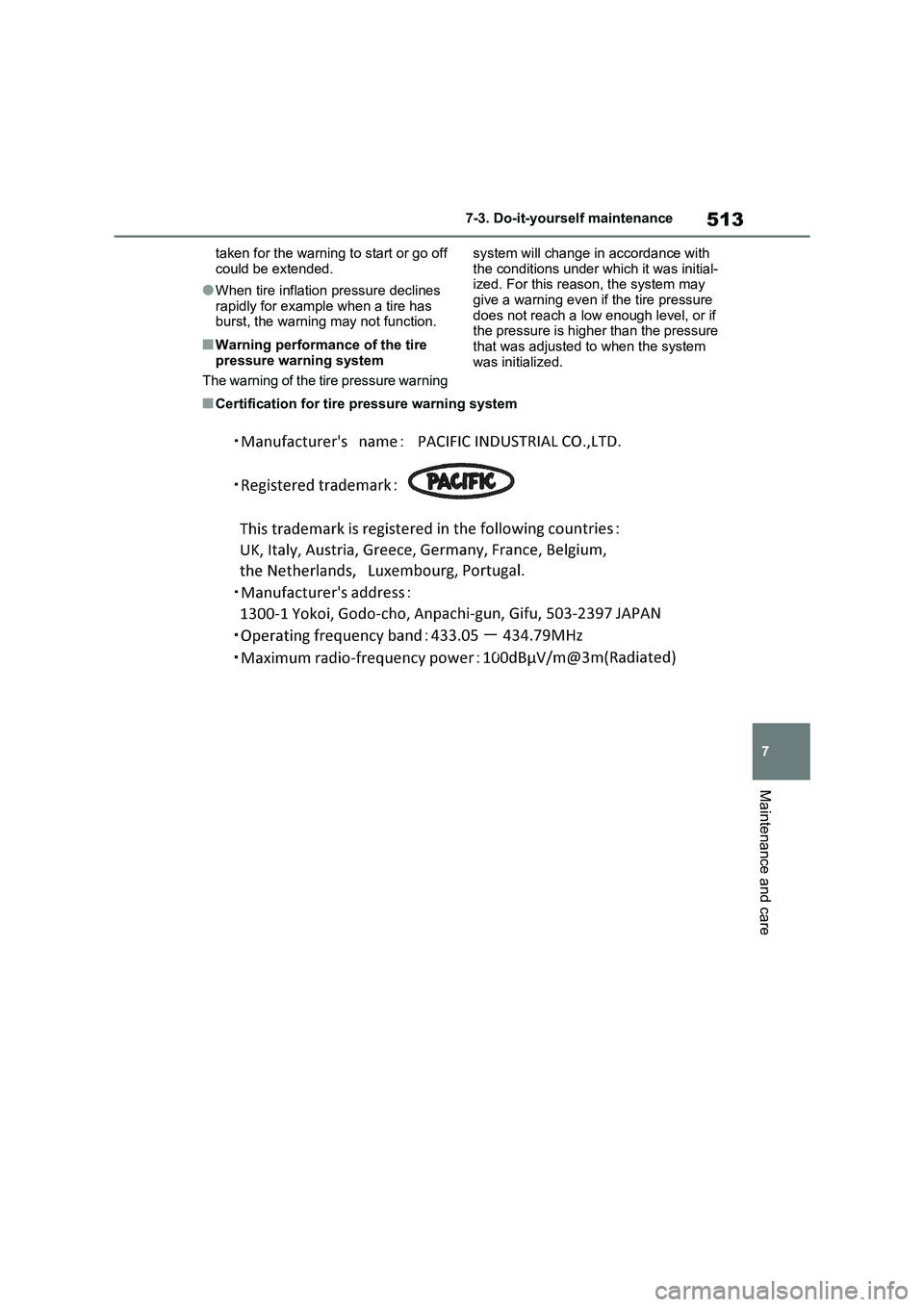2021 TOYOTA RAV4 PHEV pressure
[x] Cancel search: pressurePage 493 of 666

491
7
7-1. Maintenance and care
Maintenance and care
Remove dirt and dust using a
vacuum cleaner. Wipe dirty sur -
faces with a cloth dampened with
lukewarm water.
If dirt cannot be removed, wipe it
off with a soft cloth dampened
with neutral detergent diluted to
approximately 1%.
Wring out any excess water from
the cloth and thoroughly wipe off
remaining traces of detergent
and water.
■Shampooing the carpets
There are several commercial foaming-
type cleaners available. Use a sponge
or brush to apply the foam. Rub in over - lapping circles. Do not use water. Wipe
dirty surfaces and let them dry. Excel -
lent results are obtained by keeping the carpet as dry as possible.
■Handling the seat belts
Clean with mild s oap and lukewarm
water using a clot h or sponge. Also check the belts periodically for exces -
sive wear, fraying or cuts.
NOTICE
●Do not spray the lower part of the
windshield continuously. If water
enters the air con ditioning system intake located near the lower part of
the windshield, the air conditioning
system may not ope rate correctly.
●Do not wash the underside of the
vehicle using a high pressure car
washer.
●Do not use the was her on the area
around the charging port lid. Water could get into the AC charging inlet
and could damage the vehicle.
Cleaning and protecting
the vehicle interior
Perform cleaning in a manner
appropriate to each compo -
nent and its material.
Protecting the vehicle inte -
rior
Page 498 of 666

4967-3. Do-it-yourself maintenance
7-3.Do-it-yourself maintenance
Do-it-yourself service
precautions
If you perform maintenance by
yourself, be sure to follow the
correct procedure as given in
these sections.
Maintenance
ItemsParts and tools
12-volt battery
condition
( →P.506)
•Grease
• Conventional
wrench (for terminal
clamp bolts)
Engine/power
control unit
coolant level
( →P.503)
• “Toyota Super Long
Life Coolant” or a
similar high quality
ethylene glycol-
based non-silicate,
non-amine, non-
nitrite and non-
borate coolant with
long-life hybrid
organic acid technol -
ogy
“Toyota Super Long
Life Coolant” is pre -
mixed with 50%
coolant and 50%
deionized water.
• Funnel (used only
for adding coolant)
Engine oil level
( →P.501)
• “Toyota Genuine
Motor Oil” or equiva -
lent
• Rag or paper towel
• Funnel (used only
for adding engine
oil)
Fuses
( →P.545)
• Fuse with same
amperage rating as
original
DC/DC Con -
verter air
intake vent
( →P.536)
• Vacuum cleaner,
etc,
• Phillips screwdriver
Light bulbs
( →P.548)
• Bulb with same
number and watt -
age rating as origi -
nal
• Phillips-head screw -
driver
• Flathead screw -
driver
• Wrench
Radiator and
condenser
( →P.504)
⎯
Tire inflation
pressure
( →P.529)
• Tire pressure gauge
• Compressed air
source
Washer fluid
( →P.505)
• Water or washer
fluid containing anti -
freeze (for winter
use)
• Funnel (used only
for adding water or
washer fluid)
WARNING
The engine compartment contains
many mechanisms and fluids that may move suddenly, become hot, or
become electrically energized. To
avoid death or serious injury, observe the following precautions.
ItemsParts and tools
Page 506 of 666

5047-3. Do-it-yourself maintenance
“LOW” line
If the level is on or below the “LOW”
line, add coolant up to the “FULL” line.
( →P.611)
■Power control unit coolant
reservoir
Reservoir cap
“FULL” line
“LOW” line
If the level is on or below the “LOW”
line, add coolant up to the “FULL” line.
( →P.613)
■Coolant selection
Only use “Toyota Super Long Life Coo - lant” or a similar hig h quality ethylene
glycol based non-si licate, non-amine,
non-nitrite, and non- borate coolant with long-life hybrid org anic acid technology.
“Toyota Super Long Life Coolant” is a
mixture of 50% coolant and 50% deion - ized water. (Minimu m temperature: -
35°C [-31°F])
For more details about coolant, contact any authorized Toyota retailer or Toyota
authorized repairer, or any reliable
repairer.
■If the coolant level drops within a short time of replenishing
Visually check the radiators, hoses,
engine/power control unit coolant reser - voir caps, drain cock and water pump.
If you cannot find a leak, have any
authorized Toyota r etailer or Toyota
authorized repairer, or any reliable repairer, test the cap and check for
leaks in the cooling system.
Check the radiator and condenser,
and clear away any foreign objects.
If either of the above parts is
extremely dirty or you are not sure
of their condition, have your vehicle
inspected by any authorized Toyota
retailer or Toyota authorized
repairer, or any reliable repairer.
C
A
B
C
WARNING
■When the hybrid system is hot
Do not remove the engine/power con -
trol unit coolant reservoir caps.
The cooling system may be under
pressure and may spray hot coolant if the cap is removed, causing serious
injuries, such as burns.
NOTICE
■When adding coolant
Coolant is neither plain water nor
straight antifreeze. The correct mix - ture of water and antifreeze must be
used to provide proper lubrication,
corrosion protection and cooling. Be sure to read the anti freeze or coolant
label.
■If you spill coolant
Be sure to wash it off with water to
prevent it from damaging parts or
paint.
Checking the radiator and
condenser
Page 511 of 666

509
7
7-3. Do-it-yours elf maintenance
Maintenance and care
repairer.
Check if the treadwear indicators
are showing on the tires. Also
check the tires fo r uneven wear,
such as excessiv e wear on one
side of the tread.
Check the spare ti re condition and
pressure if not rotated.
New tread
Worn tread
Treadwear indicator
The location of treadwear indicators is
shown by a “TWI” or “ ” marks, etc.,
Tires
Replace or rotate tires in
accordance with maintenance
schedules and treadwear.
Checking tires
A
B
C
Page 512 of 666

5107-3. Do-it-yourself maintenance
molded into the sidewall of each tire.
Replace the tires if the treadwear indi -
cators are showing on a tire.
■When to replace your vehicle’s
tires
Tires should be replaced if:
●The treadwear indicators are showing on a tire.
●You have tire damage such as cuts, splits, cracks deep enough to expose
the fabric, and bulges indicating inter -
nal damage.
●A tire goes flat repeatedly or cannot
be properly repaired due to the size or location of a cut or other damage.
If you are not sure, consult with any
authorized Toyota retailer or Toyota authorized repairer, or any reliable
repairer.
■Tire life
Any tire over 6 y ears old must be checked by a qualified technician even if
it has seldom or never been used or
damage is not obvious.
■If the tread on snow tires wears down below 4 mm (0.16 in.)
The effectiveness of t he tires as snow
tires is lost.
Rotate the tires in the order shown.
To equalize tire wear and help extend
tire life, Toyota re commends that tire
rotation is carried out approximately
WARNING
■When inspecting or replacing tires
Observe the following precautions to
prevent accidents. Failure to do so may cause damage
to parts of the driv e train as well as
dangerous handling c haracteristics, which may lead to an accident result -
ing in death or serious injury.
●Do not mix tires of different makes, models or tread patterns.
Also, do not mix tires of remarkably
different treadwear.
●Do not use tire sizes other than those recommended by Toyota.
●Do not mix differently constructed tires (radial, bias-belted or bias-ply
tires).
●Do not mix summer, all season and
snow tires.
●Do not use tires that have been
used on another vehicle.
Do not use tires if you do not know how they were used previously.
●Vehicles with compact spare tire: Do not tow if your vehicle has a
compact spare tire installed.
●Vehicles with emergency tire punc -
ture repair kit: Do not tow anything
if a tire that has been repaired using the emergency tire puncture repair
kit is installed. The load on the tire
may cause unexpec ted damage to the tire.
NOTICE
■Driving on rough roads
Take particular care when driving on
roads with loose sur faces or potholes. These conditions may cause losses in
tire inflation pressure, reducing the
cushioning ability of the tires. In addi - tion, driving on rough roads may
cause damage to the tires them -
selves, as well as the vehicle’s wheels and body.
■If tire inflation pressure of each tire becomes low while driving
Do not continue drivi ng, or your tires
and/or wheels may be ruined.
Tire rotation
Page 513 of 666

511
7
7-3. Do-it-yours elf maintenance
Maintenance and care
every 5000 km (3000 miles).
Do not fail to initial ize the tire pressure
warning system after tire rotation.
Front
■When rotating the tires
Make sure that the power switch is OFF. If the tires are rotated while the power
switch is in ON, the tire position informa -
tion will not be updated.
If this accidentally occurs, either turn the
power switch to OFF and then to ON, or
initialize the system after checking that
the tire pressure is properly adjusted.
Your vehicle is equi pped with a tire
pressure warning system that uses
tire pressure warning valves and
transmitters to detect low tire infla -
tion pressure before serious prob -
lems arise.
The tire pressure warning system
of this vehicle adopts a 2-type
warning system
When “Adjust Pressure” is dis-
played (Normal Warning)
The tire pressure warning light comes
on and a buzzer sounds when the tire
inflation pressure becomes low due to
natural air leakage or outside tempera-
ture. (Ways of coping: →P.575, 624)
When “Immediately Check tire
when Safe” is displayed (Emer -
gency Warning)
The tire pressure warning light comes
on and a buzzer sounds when the tire
inflation pressure becomes low sud -
denly due to a blowout. (Ways of cop -
ing: →P.575, 582, 593)
However, the system may not be able
to detect sudden tire ruptures (bursting,
etc.).
The tire pressure detected by the
tire pressure warning system can
be displayed on the multi-informa -
tion display.
The unit can be changed.
■How to change the unit
1 Park the vehicle in a safe place
and turn the power switch off.
Changing the unit cannot be performed while the vehicle is moving.
2 Turn the power switch to ON.
Tire pressure warning sys-
tem
A
Page 514 of 666

5127-3. Do-it-yourself maintenance
3Press or of the meter
control switches on the steering
wheel and select .
4 Press or of the meter
control switches and select
“Vehicle Settings”, and then
press and hold .
5 Press or of the meter
control switches and select
“TPWS”, and then press .
6 Press or to select “Set-
ting Unit”.
7 Press or to select the
desired unit and then press .
■Routine tire inflation pressure checks
The tire pressure w arning system does
not replace routine tire inflation pressure checks. Make sure to check tire inflation
pressure as part of your routine of daily
vehicle checks.
■Tire inflation pressure
●It may take a few minutes to display
the tire inflation pressure after the
power switch is turned to ON. It may also take a few minutes to display the
tire inflation pressu re after inflation
pressure has been adjusted.
●Tire inflation pre ssure changes with
temperature. The displayed values may also be different from the values
measured using a tire pressure
gauge.
■Situations in which the tire pres - sure warning system may not oper -
ate properly
●In the following cases, the tire pres -
sure warning system may not operate
properly. • If non-genuine Toyota wheels are
used.
• A tire has been r eplaced with a tire that is not an OE (Original Equipment)
tire.
• A tire has been r eplaced with a tire that is not of the specified size.
• Tire chains, etc. are equipped.
• An auxiliary-supporte d run-flat tire is equipped.
• If a window tint tha t affects the radio
wave signals is installed. • If there is a lot of snow or ice on the
vehicle, particularly around the wheels
or wheel housings. • If the tire inflation pressure is
extremely higher t han the specified
level. • If wheels without tire pressure warning
valves and transmitters are used.
• If the ID code on the tire pressure warning valves and transmitters is not
registered in the tire pressure warning
computer.
●Performance may be affected in the
following situations. • Near a TV tower, electric power plant,
gas station, radio station, large dis -
play, airport or ot her facility that gen- erates strong radio waves or electrical
noise
• When carrying a port able radio, cellu-
lar phone, cordless phone or other wireless communication device
If tire position information is not cor -
rectly displayed due to the radio wave conditions, the display may be cor -
rected by driving and changing the
radio wave conditions.
●When the vehicle is parked, the time
Page 515 of 666

513
7
7-3. Do-it-yours elf maintenance
Maintenance and care
taken for the warning to start or go off
could be extended.
●When tire inflation pressure declines
rapidly for example when a tire has burst, the warning may not function.
■Warning performance of the tire
pressure warning system
The warning of the tire pressure warning
system will change i n accordance with
the conditions under which it was initial - ized. For this reaso n, the system may
give a warning even if the tire pressure
does not reach a low enough level, or if the pressure is higher than the pressure
that was adjusted to when the system
was initialized.
■Certification for tire pressure warning system